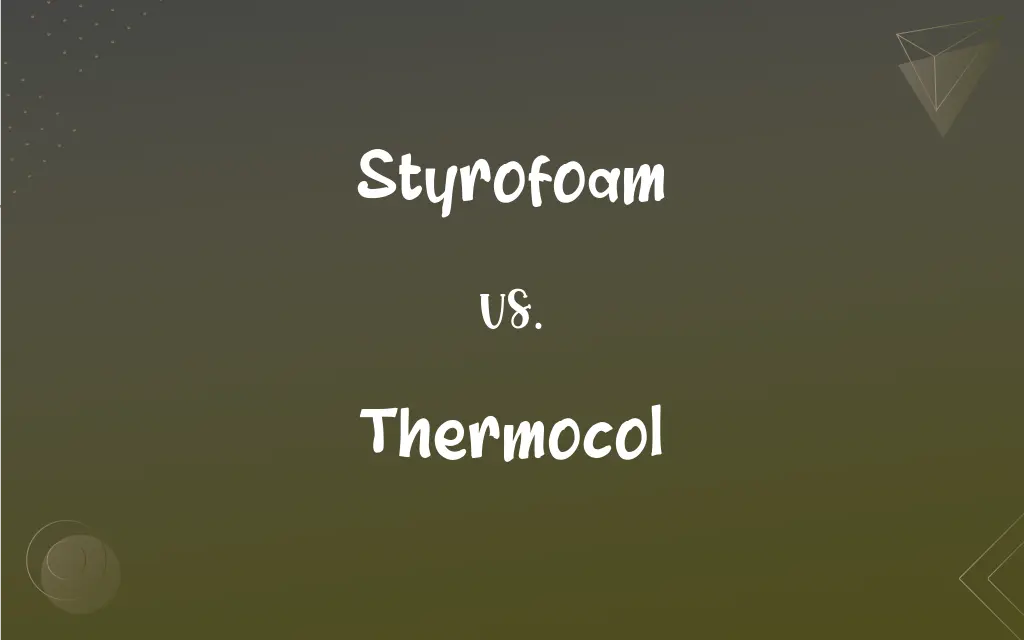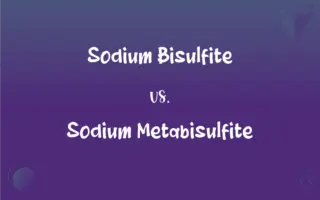Styrofoam vs. Thermocol: What's the Difference?
Edited by Aimie Carlson || By Harlon Moss || Published on December 26, 2023
Styrofoam is a trademarked brand of closed-cell extruded polystyrene foam. Thermocol is a colloquial term for expanded polystyrene (EPS) foam.

Key Differences
Styrofoam is a specific type of polystyrene foam product, trademarked by the Dow Chemical Company. It is known for its excellent insulation properties and is often used in building and construction. Thermocol, commonly used in India, is a general term for expanded polystyrene foam, used in a variety of applications, including packaging and crafts.
The production process of Styrofoam involves the extrusion of polystyrene, resulting in a strong, moisture-resistant material. Thermocol is produced by expanding polystyrene beads, which results in a lighter, air-filled foam. This difference in manufacturing results in distinct physical properties.
Styrofoam is often found in construction, for insulation and water barriers due to its durability and moisture resistance. Thermocol, being lighter and more flexible, is commonly used for packaging, disposable containers, and art projects.
In terms of environmental impact, both Styrofoam and Thermocol are non-biodegradable and pose disposal challenges. However, due to its more rigid structure, Styrofoam often finds longer-term applications, while Thermocol is more often associated with single-use products.
Overall, while Styrofoam is a specific brand of polystyrene foam known for its strength and insulation properties, Thermocol refers to a broader category of polystyrene foam products with a variety of uses, primarily in packaging and art.
ADVERTISEMENT
Comparison Chart
Composition
Closed-cell extruded polystyrene
Expanded polystyrene foam
Branding
Trademark of Dow Chemical Company
Generic term, widely used in India
Usage
Building insulation, construction
Packaging, disposable items, crafts
Physical Properties
Strong, moisture-resistant
Light, air-filled
Manufacturing Process
Extrusion of polystyrene
Expansion of polystyrene beads
ADVERTISEMENT
Styrofoam and Thermocol Definitions
Styrofoam
Known for excellent insulation properties.
Styrofoam panels are used to insulate homes.
Thermocol
Commonly used in disposable items.
Thermocol plates are popular for one-time use at events.
Styrofoam
A type of extruded polystyrene foam.
Styrofoam is used extensively for insulation in buildings.
Thermocol
Versatile material in arts and crafts.
Artists often use thermocol for creating lightweight models.
Styrofoam
Trademarked brand for polystyrene foam.
Styrofoam coolers are popular for picnics and outdoor events.
Thermocol
Light, air-filled foam.
Thermocol sheets are easy to cut and shape for crafts.
Styrofoam
Moisture-resistant construction material.
Styrofoam is often used in wet environments due to its water resistance.
Thermocol
Expanded polystyrene foam.
Thermocol is commonly used for packaging fragile items.
Styrofoam
Rigid, durable foam product.
Styrofoam is preferred for long-lasting applications.
Thermocol
A generic term for polystyrene foam.
Thermocol is often used for insulation in temporary structures.
Styrofoam
Expanded polystyrene foam, such as is used in cups and packaging.
Thermocol
(India) polystyrene
Styrofoam
A light resilient foam of polystyrene
FAQs
Is Thermocol biodegradable?
No, Thermocol is not biodegradable and poses environmental disposal challenges.
Can Styrofoam be recycled?
Recycling Styrofoam is challenging due to its chemical structure, but some specialized facilities can process it.
How is Thermocol produced?
Thermocol is produced by expanding polystyrene beads, creating a light, air-filled foam.
How is Styrofoam different from regular polystyrene?
Styrofoam is a specific type of extruded polystyrene with a closed-cell structure, making it stronger and more moisture-resistant.
What is Thermocol?
Thermocol is a colloquial term for expanded polystyrene foam, often used in packaging and crafts.
What is Styrofoam?
Styrofoam is a trademarked brand of closed-cell extruded polystyrene foam, known for its insulation properties.
Is Thermocol the same as Styrofoam?
No, while both are types of polystyrene foam, Styrofoam is a specific brand, and Thermocol is a generic term for expanded polystyrene.
Is Styrofoam safe for food packaging?
While Styrofoam is used in food packaging, there are concerns about chemicals leaching into food, especially with hot contents.
Is Thermocol harmful to the environment?
Yes, Thermocol is non-biodegradable and can contribute to environmental pollution.
How does Thermocol insulate?
Thermocol insulates by trapping air in its expanded bead structure, reducing heat transfer.
Is Styrofoam waterproof?
Yes, Styrofoam is moisture-resistant and effectively waterproof.
How long does Styrofoam take to decompose?
Styrofoam takes hundreds of years to decompose, contributing to its environmental impact.
Can Thermocol be used for thermal insulation?
Yes, Thermocol can be used for thermal insulation, though it's less effective compared to Styrofoam.
What are the health risks associated with Thermocol?
Health risks associated with Thermocol include potential chemical leaching, especially when used with hot foods or drinks.
What are common uses of Thermocol?
Thermocol is commonly used for packaging, disposable containers, and in arts and crafts.
Why is Styrofoam used in building construction?
Styrofoam is used in construction for its excellent insulation properties and moisture resistance.
What are the environmental concerns with Styrofoam?
Styrofoam poses environmental concerns due to its non-biodegradability and difficulty in recycling.
What makes Thermocol lightweight?
Thermocol is lightweight due to its air-filled expanded polystyrene structure.
Can Styrofoam be used in arts and crafts?
Yes, Styrofoam can be used in arts and crafts, though it's more rigid compared to Thermocol.
Are there safer alternatives to Styrofoam for food packaging?
Yes, safer alternatives include paper-based products, biodegradable plastics, and reusable containers.
About Author
Written by
Harlon MossHarlon is a seasoned quality moderator and accomplished content writer for Difference Wiki. An alumnus of the prestigious University of California, he earned his degree in Computer Science. Leveraging his academic background, Harlon brings a meticulous and informed perspective to his work, ensuring content accuracy and excellence.
Edited by
Aimie CarlsonAimie Carlson, holding a master's degree in English literature, is a fervent English language enthusiast. She lends her writing talents to Difference Wiki, a prominent website that specializes in comparisons, offering readers insightful analyses that both captivate and inform.































































